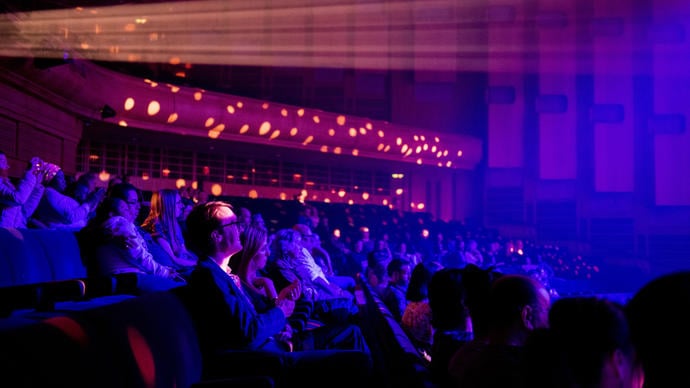
Programme and performers
Hildegard von Bingen ‘Antiphona: O successores’, Psalm antiphon for Confessors
‘Responsorium: Favus distillans’, Responsory for St Ursula and Companions, likely for Matins
Marcus Davidson Musical Harmony
Laura Moody ‘Humility and Universe as Body’ from Hildegard Portraits
Tim Lea Young Three Wings, Part 1
Hildegard von Bingen ‘Antiphona: O virtus sapientie’, Votive antiphon for Divine Wisdom
Stevie Wishart Azeruz
Laura Moody ‘Sermon and Sing’ from Hildegard Portraits
Hildegard von Bingen ‘Antiphona: O mirum admirandum’, Psalm antiphon for St Disibod
Stevie Wishart ‘O Choruscans Lux Stellarum’, On a cantus firmus by St Hildegard of Bingen
Hildegard von Bingen ‘Antiphona: O orzchis Ecclesia’, Antiphon for Dedication of a Church
Marcus Davidson O Boundless Ecclesia
Laura Moody ‘O Woman’ and ‘Love’ from Hildegard Portraits
Emily Levy How Sweetly You Burn
Hildegard von Bingen ‘Antiphona: Unde quocumque venientes’, Antiphon for St Ursula
Laura Moody ‘The Living Light’ from Hildegard Portraits
Voice Trio:
Victoria Couper
Clemmie Franks
Emily Burn
Song texts
Please download the PDF version to view song texts and translations.
Artist biographies
Voice is an exciting, female vocal trio. In its 18 years together, the singers have built a dedicated fan-base across the world; a rich, varied repertoire of their own arrangements, new commissions, and rarely performed early music; and they have honed a truly unique sound. Victoria Couper, Clemmie Franks and Emily Burn first began singing together in Oxford as members of the Oxford Girls’ Choir, before going on to form the trio in 2006, as well as forging their own successful, diverse careers. They draw on their individual musical interests and experiences to create thrilling timbres and a seamless blend.
Their interest in early music can be traced back to their performances and recordings of the medieval chant of St Hildegard of Bingen, which they learned as members of Stevie Wishart’s group Sinfonye. The singers still perform with Sinfonye today and, as a trio, Voice continues to perform Hildegard’s music and has commissioned new works inspired by her words and chant.
The trio has toured throughout the UK, USA and Europe with two self-released albums: Musical Harmony (2013) and Patterns of Love (2015). Collaborative releases include I Have Set My Hert So Hy (Avie, 2015) with the Dufay Collective, and a Janáček album with Nicky Spence and Julius Drake (Hyperion, 2019). Voice released its latest album, Hildegard Portraits on SOMM Recordings in June 2022. The group continues to tour its multimedia show Hildegard Transfigured, with visual artist Innerstrings.
Lighting by Dragonfly Lighting Ltd
Dragonfly Lighting provides creative lighting and video solutions across the live events, broadcast, corporate and film and television sectors, working closely with its clients to bring their creative visions to life.
Calligraphy by Tabitha Lincoln

Our Patrons and supporters
Find out about our Patrons, who help us keep our programme accessible to everyone and allow us to continue investing in the artists and communities we work with.
Love the arts? Become a Patron to engage more closely with our programme.

Who we are
Meet our management team, our Board and the Trustees of our charitable arm, Barbican Centre Trust.
